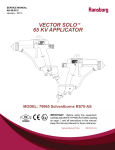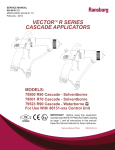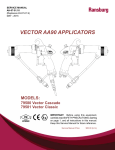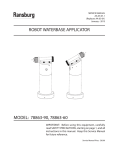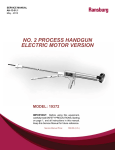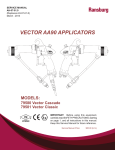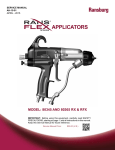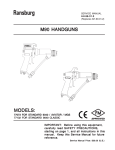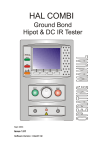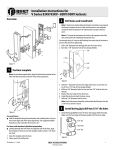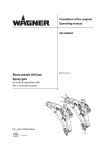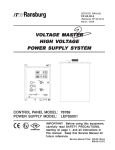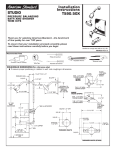Download AH-08-03.6 - Ransburg.com
Transcript
SERVICE MANUAL AH-08-03.6 January - 2013 Ransburg VECTOR SOLO WATERBORNE APPLICATORS TM MODEL: 79901 Waterborne RS90-WB IMPORTANT: Before using this equipment, carefully read SAFETY PRECAUTIONS, starting on page 1, and all instructions in this manual. Keep this Service Manual for future reference. Service Manual Price: $50.00 (U.S.) Ransburg NOTE: This manual has been changed from revision AH-08-03.5 to revision AH-08-03.6. Reasons for this change are noted under “Manual Change Summary” on page 61 of this manual. AH-08-03.6 Ransburg Vector Solo Waterborne Applicators - Contents AIR HOSE LENGTH AND TYPE................................................................................................ 48 CONTENTS PAGE SAFETY:1-4 SAFETY PRECAUTIONS ...........................................................................................................1 HAZARDS / SAFEGUARDS .......................................................................................................2-4 ATEX/FM:5-8 EUROPEAN ATEX DIRECTIVE ................................................................................................. 5 EUROPEAN ATEX LABELS ....................................................................................................... 6 FM CONFIGURATION DRAWING ............................................................................................. 7-8 INTRODUCTION:9-12 GENERAL DESCRIPTION ....................................................................................................... 9 79901 VECTOR SOLO WATERBORNE SPECIFICATIONS ................................................... 10 VECTOR SOLO WATERBORNE ELECTROSTATIC SPRAY APPLICATOR ............................ 11 VECTOR SOLO TYPICAL WATERBORNE INSTALLATION .................................................... 12 INSTALLATION:13-18 WATERBORNE ISOLATION SYSTEM INSTALLATION GUIDELINES ......................................13-14 WATERBORNE HOSE FITTING INSTALLATION ......................................................................14 79901 VECTOR SOLO WATERBORNE INSTALLATION ..........................................................15 INSTALLATION ..........................................................................................................................16-18 OPERATION:20-23 APPLICATOR OPERATION ....................................................................................................... 20-21 FLUSHING / COLOR CHANGE PROCEDURE ......................................................................... 21-22 FLUID NOZZLE / AIR CAP ......................................................................................................... 23 MAINTENANCE:24-44 SUITABLE SOLVENTS FOR CLEANING VECTOR SOLO APPLICATORS ..............................24 ROUTINE SCHEDULE ...............................................................................................................25-26 APPLICATOR REPAIR ...............................................................................................................26-27 AIR CAP .....................................................................................................................................27 FLUID NOZZLE ..........................................................................................................................28-29 NEEDLE / ELECTRODE ............................................................................................................29 NEEDLE / ELECTRODE RESISTANCE TESTING ....................................................................30 BARREL REMOVAL ..................................................................................................................30-33 NEEDLE SHAFT REMOVAL / REPLACEMENT ........................................................................34-35 POWER MODULE REMOVAL ...................................................................................................35-36 HANDLE DISASSEMBLY ...........................................................................................................36-38 POWER MODULE - FLUID FITTING REMOVAL .......................................................................38-39 TEST AND MAINTENANCE KIT USAGE (79870-00) ................................................................40-43 TROUBLESHOOTING GUIDE ...................................................................................................44 (Continued On Next Page) AH-08-03.6 Vector Solo Waterborne Applicators - Contents CONTENTS (Cont.) PARTS IDENTIFICATION: Ransburg PAGE 45-58 VECTOR SOLO APPLICATOR PARTS BREAKDOWN ............................................................ 45 VECTOR SOLO WATERBORNE APPLICATOR PARTS LIST .................................................. 46-47 VECTOR SOLO RS90-WB MODEL IDENTIFICATION ............................................................. 47 AIR HOSE LENGTH AND TYPE................................................................................................ 48 TRIGGER SELECTION.............................................................................................................. 48 SPRAY SELECTION.................................................................................................................. 48 FLUID HOSE SELECTION........................................................................................................ 48 79853-00 NEEDLE SHAFT / PARTS LIST ................................................................................ 49-50 POWER MODULE REPLACEABLE PARTS / PARTS LIST ...................................................... 51 ACCESSORIES / PARTS LIST ................................................................................................. 52-56 PARTS COMPARISON / TRANS-TECH. ATOMIZATION PARTS LIST .................................... 57 VECTOR SOLO WATERBORNE RECOMMENDED SPARE PARTS ....................................... 58 WARRANTY POLICIES: 60 LIMITED WARRANTY ............................................................................................................... 60 AH-08-03.6 Ransburg Vector Solo Waterborne Applicators - Safety SAFETY SAFETY PRECAUTIONS Before operating, maintaining or servicing any Ransburg electrostatic coating system, read and understand all of the technical and safety literature for your Ransburg products. This manual contains information that is important for you to know and understand. This information relates to USER SAFETY and PREVENTING EQUIPMENT PROBLEMS. To help you recognize this information, we use the following symbols. Please pay particular attention to these sections. A WARNING! States information to alert you to a situation that might cause serious injury if instructions are not followed. A CAUTION! States information that tells how to prevent damage to equipment or how to avoid a situation that might cause minor injury. A NOTE is information relevant to the procedure in progress. While this manual lists standard specifications and service procedures, some minor deviations may be found between this literature and your equipment. Differences in local codes and plant requirements, material delivery requirements, etc., make such variations inevitable. Compare this manual with your system installation drawings and appropriate Ransburg equipment manuals to reconcile such differences. ! WARNING The user MUST read and be familiar with the Safety Section in this manual and the Ransburg safety literature therein identified. This hand held device is intended to be used by trained personnel ONLY. This manual MUST be read and thoroughly understood by ALL personnel who operate, clean or maintain this equipment! Special care should be taken to ensure that the WARNINGS and safety requirements for operating and servicing the equipment are followed. The user should be aware of and adhere to ALL local building and fire codes and ordinances as well as NFPA33 EN 50176 SAFETY STANDARD, or applicable country safety standards prior to installing, operating, and/or servicing this equipment. ! WARNING The hazards shown on the following page may occur during the normal use of this equipment. Please read the hazard chart beginning on page 2. Careful study and continued use of this manual will provide a better understanding of the equipment and process, resulting in more efficient operation, longer trouble-free service and faster, easier troubleshooting. If you do not have the manuals and safety literature for your Ransburg system, contact your local Ransburg representative or Ransburg. 1 AH-08-03.6 Ransburg Vector Solo Waterborne Applicators - Safety AREA Tells where hazards may occur. Spray Area HAZARD SAFEGUARDS Fire Hazard Fire extinguishing equipment must be present in the spray area and tested periodically. Tells what the hazard is. Improper or inadequate operation and maintenance procedures will cause a fire hazard. Protection against inadvertent arcing that is capable of causing fire or explosion is lost if any safety interlocks are disabled during operation. Frequent power supply shutdown indicates a problem in the system requiring correction. Tells how to avoid the hazard. Spray areas must be kept clean to prevent the accumulation of combustible residues. Smoking must never be allowed in the spray area. The high voltage supplied to the atomizer must be turned off prior to cleaning, flushing or maintenance. When using solvents for cleaning: Those used for equipment flushing should have flash points equal to or higher than those of the coating material. Those solvents used for cleaning must have a flash point at minimum of 5°C (9°F) greater than the ambient temperature. It is the end users responsibility to insure this condition is met. Spray booth ventilation must be kept at the rates required by local and/or country codes. In addition, ventilation must be maintained during cleaning operations using flammable or combustible solvents. Electrostatic arcing must be prevented. Test only in areas free of combustible material. Testing may require high voltage to be on, but only as instructed. Non-factory replacement parts or unauthorized equipment modifications may cause fire or injury. If used, the key switch bypass is intended for use only during setup operations. Production should never be done with safety interlocks disabled. The paint process and equipment should be set up and operated in accordance with local and/or country safety codes. AH-08-03.6 2 Ransburg AREA Tells where hazards may occur. Toxic Substances Vector Solo Waterborne Applicators - Safety HAZARD Tells what the hazard is. Certain material may be harmful if inhaled, or if there is contact with the skin. SAFEGUARDS Tells how to avoid the hazard. Follow the requirements of the Material Safety Data Sheet supplied by coating material manufacturer. Adequate exhaust must be provided to keep the air free of accumulations of toxic materials. Use a mask or respirator whenever there is a chance of inhaling sprayed materials. The mask must be compatible with the material being sprayed and its concentration. Equipment must be as prescribed by an industrial hygienist or safety expert, and be approved. Explosion Hazard / Incompatible Materials Halogenated hydrocarbon solvents, for example: methylene chloride and 1,1,1, - Trichloroethane, are not chemically compatible with the aluminum that might be used in many system components. The chemical reaction caused by these solvents reacting with aluminum can become violent and lead to an equipment explosion. Spray applicators require that aluminum inlet fittings be replaced with stainless steel. (See "Accessories" in the "Parts Identification" section.) Aluminum is widely used in other spray application equipment - such as material pumps, regulators, valves, etc. Check all other equipment items before use and make sure they can also be used safely with these solvents. Read the label or data sheet for the material you intend to spray. If in doubt as to whether or not a coating or cleaning material is compatible, contact your material supplier. Any other type of solvent may be used with aluminum equipment. Electrical Equipment High voltage equipment is utilized. Arcing in areas of flammable or combustible materials may occur. Personnel are exposed to high voltage during operation and maintenance. Turn the power module OFF before working on the equipment. Protection against inadvertent arcing that may cause a fire or explosion is lost if safety circuits are disabled during operation. An electrical arc can ignite coating materials and cause a fire or explosion. 3 Test only in areas free of flammable or combustible material. Testing may require high voltage to be on, but only as instructed. Production should never be done with the safety circuits disabled. Before turning the high voltage on, make sure no objects are within the sparking distance. AH-08-03.6 Ransburg Vector Solo Waterborne Applicators - Safety AREA Tells where hazards may occur. Spray Area HAZARD Tells what the hazard is. Electrostatic Arcing SAFEGUARDS Tells how to avoid the hazard. Never operate the applicator without properly grounding the following. A.Operators Operators must be grounded. Rubber soled insulating shoes should not be worn. Grounding leg or wrist straps may be used. Operators must maintain contact with the handle of the applicator. If work gloves are used, the palm section must be cut out. Operators must remove from themselves all metal objects that are not grounded. NOTE: REFER TO NFPA-33, EN 50176 REGARDING OPERATOR GROUNDING OR SPECIFIC COUNTRY SAFETY CODE. B. Parts being sprayed. Resistance between the part and a grounded conveyor must not exceed 1 megohm. C. Every metal and conductive object in the spray area. This includes the booth, parts hangers, fire extinguishers, conductive flooring, etc. Grounded conductive flooring must be provided in the spray area. Turn off voltage at the power module before flushing out, cleaning, or removing any parts from the applicator. Never install an applicator into a fluid system using an isolated solvent supply. Do not touch applicator electrode while applicator is energized. General Use and Maintenance Improper operation or main-tenance may create a hazard. Personnel must be given training in accordance with the requirements of NFPA-33, EN 50176. Personnel must be properly trained in the use of this equipment. Instructions and safety precautions must be read and understood prior to using this equipment. Comply with appropriate local, state, and national codes governing ventilation, fire protection, operation maintenance, and housekeeping. AH-08-03.6 4 Ransburg Vector Solo Waterborne Applicators - Atex/FM EUROPEAN ATEX DIRECTIVE 94/9/EC, ANNEX II, 1.0.6 The following instructions apply to equipment covered by certificate number Sira 08ATEX5060X: 8.The certification of this equipment relies upon the following materials used in its construction: 1.The equipment may be used with flammable gases and vapors with apparatus groups II and with temperature class T6. If the equipment is likely to come into contact with aggressive substances, then it is the responsibility of the user to take suitable precautions that prevent it from being adversely affected, thus ensuring that the type of protection provided by the equipment is not compromised. 2. The equipment is only certified for use in ambient temperatures in the range 0°C to +40°C and should not be used outside this range. 3.Installation shall be carried out by suitably trained personnel in accordance with the applicable code of practice e.g. EN 60079-14:1997. 4.Inspection and maintenance of this equipment shall be carried out by suitably trained personnel in accordance with the applicable code of practice e.g. EN 60079-17. 5.Repair of this equipment shall be carried out by suitable trained personnel in accordance with the applicable code of practice e.g. EN 60079-19. 6.Putting into service, use, assembling, and adjustment of the equipment shall be fitted by suitably trained personnel in accordance with the manufacturer's documentation. Refer to the "Table of Contents" of this service manual: a. Installation b. Operation c. Maintenance d. Parts Identification 7.Components to be incorporated into or used as replacement parts of the equipment shall be fitted by suitably trained personnel in accordance with the manufacturer's documentation. 5 Aggressive substances: e.g. acidic liquids or gases that may attack metals, or solvents that may affect polymeric materials. Suitable precautions: e.g. regular checks as part of routine inspections or establishing from the material's data sheets that it is resistant to specific chemicals. Refer to "Specifications" in the "Introduction" section: a. All fluid passages contain stainless steel or nylon fittings. b. High voltage cascade is encapsulated with a solvent resistant epoxy. 9.A recapitulation of the certification marking is detailed in the "ATEX" section, on the next page, drawing numbers: 79846-01 and 79852-01. 10. The characteristics of the equipment shall be detailed e.g. electrical, pressure, and voltage parameters. The manufacturer should note that, on being put into service, the equipment must be accompanied by a translation of the instructions in the language or languages of the country in which the equipment is to be used and by the instructions in the original language. AH-08-03.6 Ransburg Vector Solo Waterborne Applicators - Atex/FM Vector Solo Waterborne 79901 ATEX Product Marking Definitions Label 79846-03 Ex Certificate Number: Sira 08ATEX5060X Sira = Notified Body performing EC-type examination 08 = Year of certification ATEX = Reference to ATEX Directive 5 = Protection Concept Code (code 5 is titled Encapsulation) 060 = Document serial number X = Special conditions for safe use apply Label 79852-03 Special conditions for safe use: The Vector Solo 79965 Applicators shall only be used with associated Ransburg 79727-XX Air Hose Assembly. It is the end users responsibility to insure the air hose is properly grounded to true earth ground. Product Marking II 2 G Ex = Specific marking of explosive protection II = Equipment Group hazardous area characteristics 2 = Equipment Category G = Type of explosive atmosphere (gases, vapors, or mists) FM Configuration This applicator is FM approved when configured to drawing 79945 shown on pages 7 and 8. EEx 0.24mJ = The Vector Solo 79965 Applicators are suitable for use in manual spraying installations complying with EN 50 050 as they are a Type A class with a discharge energy limit of 0.24mJ. AH-08-03.6 6 Ransburg Vector Solo Waterborne Applicators - Atex/FM VECTOR SOLO RS90-WB WATER BASED 79901 - ABCDE BASE OPTION MODEL NO. DESIGNATIONS (ORDERING INFORMATION ONLY) "D" DESIGNATIONS "C" DESIGNATIONS "E" DESIGNATIONS "A" DESIGNATIONS CONFIGURATION DWG. 79945 REV E 7 AH-08-03.6 Ransburg Vector Solo Waterborne Applicators - Atex/FM VECTOR SOLO RS90-AS SOLVENT BASED 79900 - ABCDE BASE OPTION MODEL NO. DESIGNATIONS (ORDERING INFORMATION ONLY) OPTION "A" DESIGNATIONS AIR HOSE TYPE AND LENGTH 1 FOR STANDARD AIR HOSE ASSEMBLY, 10 METER (33')-PART NUMBER: 79727-10 2 FOR STANDARD AIR HOSE ASSEMBLY, 15 METER (49')-PART NUMBER: 79727-15 3 FOR STANDARD AIR HOSE ASSEMBLY, 20 METER (66')-PART NUMBER: 79727-20 4 FOR STANDARD AIR HOSE ASSEMBLY, 30 METER (99')-PART NUMBER: 79727-30 5 FOR QD AIR HOSE ASSEMBLY, 10 METER (33')-PART NUMBER: 79727-11 6 FOR QD AIR HOSE ASSEMBLY, 15 METER (49')-PART NUMBER: 79727-16 7 FOR QD AIR HOSE ASSEMBLY, 20 METER (66')-PART NUMBER: 79727-21 8 FOR QD AIR HOSE ASSEMBLY, 30 METER (99')-PART NUMBER: 79727-31 OPTION "B" DESIGNATIONS FLUID INLET TUBE 1 FOR STANDARD FLUID TUBE, .093" ID-PART NUMBER: 79878-01 2 FOR COILED FLUID TUBE, .125" ID-PART NUMBER: 79871-00 3 FOR FLUID TUBE, 1/8" ID-PART NUMBER: 79878-02 4 FOR FLUID TUBE, 1/4" ID-PART NUMBER: 79878-03 OPTION "C" DESIGNATIONS TRIGGER TYPE 2 FOR TWO FINGER TRIGGER-PART NUMBER: 79787-00 OPTION "D" DESIGNATIONS SPRAY TECHNOLOGY 0 FOR STANDARD SPRAY, 65V CAP, #44 NOZZLE-PART NUMBER: 79374-65 & 79377-44 1 FOR STANDARD SPRAY, 65V CAP, #45 NOZZLE-PART NUMBER: 79374-65 & 79377-45 2 FOR TRANSTECH SPRAY, 122V CAP, #245 NOZZLE-PART NUMBER: 79374-122 & 79552-245 3 FOR ROUND SPRAY-PART NUMBER: 79662-00 & 79559-00 4 FOR STANDARD SPRAY, 65V CAP, #48 NOZZLE-PART NUMBER; 79374-65 & 79377-48 APPROVED SPARE FLUID NOZZLES LIST 80101-46 (1.06mm ID, STD. WEAR), 79377-47 (.71mm ID, STD. WEAR), 80101-48 (1.19mm ID, STD. WEAR), 79377-144 (1.40mm ID, HIGH WEAR), 80101-145 (1.78mm ID, HIGH WEAR), 79377-146 (1.06mm ID, HIGH WEAR), 80101-147 (.71mm ID, HIGH WEAR), 79552-244 (1.40mm ID, STD. WEAR), 80122-444 (1.40mm ID, HIGH WEAR), 79552-345 (1.78mm ID, HIGH WEAR) OPTION "E" DESIGNATIONS FLUID HOSE LENGTH 0 FOR NO FLUID HOSE 1 FOR FLUID HOSE, 10m-PART NUMBER: 79548-10 2 FOR FLUID HOSE, 15m-PART NUMBER: 79548-15 3 FOR FLUID HOSE, 20m-PART NUMBER: 79548-20 4 FOR FLUID HOSE, 30m-PART NUMBER: 79548-31 CONFIGURATION DWG. 79943 REV C AH-08-03.6 8 Ransburg Vector Solo Waterborne Applicators - Introduction INTRODUCTION GENERAL DESCRIPTION The Vector SoloTM Waterborne is an air atomizing applicator powered only by a pressurized air source. Pressurized air creates rotation of a turbine generator that powers a cascade. The cascade generates a high voltage DC charge to the electrode creating an electrostatic field between the atomizer and the target. A regulated pressure fluid system delivers coating material to the atomizer. At the time of triggering the applicator, fan and atomization air is introduced, which atomizes the coating material into a spray mist. The atomized spray particles under the influence of the electrostatic field become electrically charged. The charged particles are attracted to, and deposited on, the target object. The forces between the charged particles and the grounded target are sufficient to turn most normal overspray around and deposit it on the back surface of the target. Therefore, a high percentage of the coating is deposited on the target. One of the many features of the Vector Solo applicator system is that the electrical energy, which is available from the resistive charging electrode, is limited to the optimum level of safety and efficiency. The system is incapable of releasing sufficient electrical or thermal energy during normal operating conditions to cause ignition of specific hazardous materials in their most easily ignited concentrations in air. The Vector Solo Waterborne is designed to be used with water-based materials only, and the instructions in this manual refer to the use of this applicator with water-based materials only. Waterbased materials are those defined as liquids which do not sustain burning when tested in accordance with ASTM D 4206 (FM 7260), as opposed to solvent-based spray materials, which are liquids that are flammable or combustible (FM 7260). Combustible liquids are those liquids classified as Class II or Class III, and have closed-cup flash points at or above 37.8°C (100°F) (NFPA-33). Flamable liquids are those liquids classified as Class I, and haved closed cup flash points less than 37.8°C (100°F) and a Reid vapor pressure not exceeding 2068.6mm of Hg (40 psi) at 37.8°C (100°F) (NFPA-33). ! WARNING When more than one waterborne applicator is fed from a common isolated fluid supply, there is a potential for electrical energy discharge through any other applicators when one applicator is triggered. Depending upon the system capacity, this discharge could be hazardous. It is best to only install one applicator per isolated supply. As the applicator electrode approaches ground, applicator circuitry causes the high voltage to approach zero while the current approaches its maximum value. 9 AH-08-03.6 Ransburg Vector Solo Waterborne Applicators - Introduction 79901 VECTOR SOLO WATERBORNE SPECIFICATIONS Environmental/Physical Applicator Length: 292mm (11.5-inches) Weight: Hose 79727-XX Lengths (Std): 941 grams (33.2 oz.) Atomizer Nozzle Assembly (Std): 10m, 15m, 20m, and 30m 79374-65, 79377-44 (1.4mm) Electrical Operating Voltage: 85kV DC (-) maximum Current Output: 130 microamperes maximum Paint Resistance:* Materials must be classified as a waterborne material as explained on the previous page. Part Sprayability: Determine sprayability of part to be coated using 76652, Test Equipment (See current "Paint, HV & SCI Test Equipment" service manual.) Mechanical Fluid Flow Capacity: 1000 ml/minute** Wetted Parts: Stainless, polyethylene, nylon, acetal polymer Operating Pressure (Air Spray) Fluid: (0-6.9 bar) 0-100 psi Air: (0-6.9 bar) 0-100 psi Ambient Temp.: 40°C to 0°C (104°F to 32°F) Consumption: 470 SLPM (16.6 SCFM) @ 2.8 bar (40 psig) @ Handle Inlet Sound Level: 92dB (A) @ 2.8 bar (40 psig) Inlet, 1m from applicator Vibration Level: 0.065 m/S2 @ 2.8 bar (40 psig) @ Handle Inlet ** This reflects the maximum fluid volume the applicator can deliver. The maximum spray volume that can be effectively atomized depends on fluid rheology, spray technology, and finish quality required. AH-08-03.6 10 Ransburg Vector Solo Waterborne Applicators - Introduction 3 2 9 1 4 5 10 8 13 6 12 11 7 14 Figure 1: Vector Solo Waterborne Electrostatic Spray Applicator VECTOR SOLO WATERBORNE ELECTROSTATIC SPRAY APPLICATOR No. 1 2 3 4 5 6 7 11 Description Needle/Electrode Barrel Replaceable Hook Fan Air Adjustment Fluid Needle Travel Adjustment Waterborne Hose Air Inlet Connection No. 8 9 10 11 12 13 14 Description kV Setpoint Switch Voltage On/Off Indicator Light Trigger Turbine Air Exhaust Voltage On/Off Lever Power Module Waterborne Source Connection AH-08-03.6 Ransburg Vector Solo Waterborne Applicators - Introduction Figure 2: Vector Solo Typical Waterborne Installation VECTOR SOLO TYPICAL WATERBORNE INSTALLATION No. 1 2 3 4 5 6 AH-08-03.6 Description Vector Solo Waterborne Ball Valve Air Regulator W/Pressure Gauge Air / Water Separator Main Air Supply Line Fluid Supply (Isolated) No. 7 8 9 10 11 Description Fluid Regulator Air Hose (79727-XX) Air Hose Ground Wire Fluid Line Isolated Fluid System (Protection required from human contact) 12 Ransburg Vector Solo Waterborne Applicators - Installation INSTALLATION ! WARNING Typical installations to spray non-flammable conductive materials (waterborne materials) must not be used to handle flammable materials (solvent based materials). Refer to the "Introduction" section for definition of water-based and solvent-based materials. WATERBORNE ISOLATION SYSTEM INSTALLATION GUIDELINES Using waterborne coating with electrostatic equipment requires that the fluid source be isolated from ground. Precautions should be taken to ensure operator safety and system efficiency. The following guidelines should be followed: • The fluid lines and source MUST be isolated from ground. an isolating paint stand or similar isolating (non-porous) material MUST be used. ! CAUTION Never use wood products, wooden boxes, pallets, or boards as an isolator. wood contains moisture and is a poor insulator. Electrical current passing through these materials can ignite them, causing a hazardous condition. 13 • Isolation stands MUST be at least 45.7 cm (18 inches) from grounded booth walls, chain link fences, or other grounded objects. • Air hoses to the pressure pot or pump on the insulating stand should be non-conductive plastic. Many rubber hoses will have static grounding circuits or carbon content and are NOT suitable for this application. • All charged (isolated) systems MUST be inside a fence or cage to prevent contact by personnel. An interlock system MUST be provided that interrupts high voltage flow to the applicator if the gate is opened. • Air regulators for pots or pumps should be mounted remotely outside the fence or cage area to facilitate changes in pressure without shutting the system down. • Grounding hooks at the cage MUST be used to ground the system when personnel are working close by. • Fluid lines to the applicator MUST be protected from scraping and abrasion on the floor or sharp metal edges that could lead to voltage pin holing and loss of kV on the charged system. • Cleanliness and maintenance are extremely critical. • Refer to "Installation - 79901 RS90 Waterborne Installation" in the "Installation" section of this manual. AH-08-03.6 Ransburg Vector Solo Waterborne Applicators - Installation Air Hose ! WARNING For proper safe function of the applicator, the 79727-XX Air Hose must be used (either standard or quick disconnect style). Fluid Hose Recommendation Ransburg recommends using either a 3/16" ID (79524) or an 1/4" ID (79525) Fluid Hose Assembly. This assembly is made to specifically fit the applicator. This hose is available from your authorized Ransburg distributor. Available hose lengths are listed in "Accessories" in the "Parts Identification" section of this manual. ! CAUTION Any user installed fluid hose used must be rated for 6.9 bar (100 psig) working pressure minimum. WATERBORNE HOSE FITTING INSTALLATION For 79901 RS90 Solo - Waterborne: Ransburg supplies the waterborne fluid hose factory pre-assembled to the applicator unit. Standard hose lengths are 10m, 15m, 20m, and 30m. To modify the hose length, use the following procedures. All adjustments must be made at the supply end of the system. 4. Carefully score the outer jacket linearly and then radially approximately 45.7 cm (18-inches) back from the cut end. Split the outer jacket along the linear score mark and peel it away from the inner sheath. Then remove the jacket completely by tearing along the radial score mark. ! WARNING Special care must be taken when removing the sheathing from the fluid hose. Make sure all tools are very sharp and only score the surface of the sheath. Inserting the knife too deep can score the surface of the core material and lead to pin-holing and failure of the hose. 5. Lightly score the inner sheath linearly and then radially 1-inch from the outer jacket. Split the inner sheath along the linear score mark and peel it away from the core fluid hose. Then remove the sheath completely by tearing along the radial score mark. 6. Roll the inner sheath back over itself until it touches the outer jacket. 7. Cut approximately 1/4-inch of inner sheath off. 1. Remove the male connector and swivel fitting from the end of the fluid hose by turning the nut of the male connector counter-clockwise while holding its main body. 2. Remove the male connector nut from the fluid hose. 3. Determine the hose length that is needed and cut the hose off squarely. AH-08-03.6 14 Ransburg Vector Solo Waterborne Applicators - Installation Filters 1. Install an air filter assembly on the air outlet of the main air regulator. The filter should be 5 micron with a maximum working pressure of at least 6.9 bar (100 psig). Screw the fitting into the filter inlet. The filter MUST be installed with the arrow pointing in the direction of flow. (Refer to the appropriate Filter Assembly manual for Installation Instructions.) 2. Ransburg recommends that a fluid filter be installed at the output of the fluid supply (pressure pot, pump, circulating system, etc.). It is the end user's responsibility to install the proper filter that meets their system's requirements. Clean Dry Air Air used for the 79901 Vector Solo waterborne applicator should be clean and dry. Ransburg specifies clean and dry air as: Class 3 air quality, which is defined as a 5 micron particle size and has a dew point of -4F (-20C). The relative humidity of the air should be 5%. 79901 VECTOR SOLO WATERBORNE INSTALLATION ! WARNING The user MUST read and be familiar with the "Safety" section of this manual. This hand held device is intended to be used by trained personnel ONLY. This manual MUST be read and thoroughly understood by ALL personnel who operate, clean, or maintain this equipment! Special care should be taken to ensure that the warnings and requirements for operating and servicing safely are followed. The user should be aware of and adhere to ALL local building and fire codes and ordinances as well as NFPA, OSHA, and all related country safety codes prior to installing, operating, and/or servicing this equipment. Personnel MUST be GROUNDED to prevent a shock or spark during electrostatic operation. Install and route the hoses so they are NOT exposed to temperatures in excess of 49°C (120°F) and so that all hose bends are NO LESS than a 15cm (6-inch) radius. Failure to comply with these parameters could cause equipment malfunction that might create HAZARDOUS CONDITIONS! 15 AH-08-03.6 Ransburg Vector Solo Waterborne Applicators - Installation Interlocks Required Interlock the solvent supply with the main supply air to the applicator. If solvents with a flashpoint below the normal ambient temperature of the spray booth are used, the interlock must be installed. When solvent is On, main supply air to the applicator is Off. Interlocks are user supplied. ! WARNING The solvent supply must be interlocked with applicator supply air. If solvents with a flash point below the normal ambient temperature of the spray booth are used, the interlock must be installed. INSTALLATION The following assemblies are available for purchase: WATERBORNE HOSE ASSEMBLIES Part # Description 79525-10 79525-15 79525-20 79525-25 79525-30 79524-10 79524-15 79524-20 79524-25 79524-30 Fluid Hose Assembly, 1/4" ID X 10m long Fluid Hose Assembly, 1/4" ID X 15m long Fluid Hose Assembly, 1/4" ID X 20m long Fluid Hose Assembly, 1/4" ID X 25m long Fluid Hose Assembly, 1/4" ID X 30m long Fluid Hose Assembly, 3/16" ID X 10m long Fluid Hose Assembly, 3/16" ID X 15m long Fluid Hose Assembly, 3/16" ID X 20m long Fluid Hose Assembly, 3/16" ID X 25m long Fluid Hose Assembly, 3/16" ID X 30m long Figure 3: Conductive Fluid Conversion Kit In order for the waterborne hose assembly to work properly, it must be correctly installed onto a current Vector Solo applicator. The following steps describe how to install a waterborne hose onto a Vector Solo. 1. Ensure there is a true earth ground connection available. ! The air hose ground must be connected to true earth ground. 2. Isolate the fluid source from true earth ground. 3. Ensure electrostatic On/Off lever is in the Off position. Figure 4: Voltage Off Lever Position (Bottom View) 4. Connect the air hose ground wire to true earth ground. ! In order to use a waterborne hose, the Conductive Fluid Conversion Kit (79891-00) must be used as well. WARNING WARNING It is the end users responsibility to insure the ground end of the 79727-XX air hose is connected to true earth ground. 5. Connect the air hose to the applicator, thread is left hand pitch, counter-clockwise to tighten. AH-08-03.6 16 Ransburg Vector Solo Waterborne Applicators - Installation CW CW 60% V OL T AG E 100% V OL T AGE Figure 7: Waterborne Hose Assembly Figure 5: Air Hose Connection 6. Install the hose bracket [1] onto the fluid fitting [2] using the bracket nut [3]. NOTE Make sure to align the pin on the fluid fitting [2] with the hole on the groove on the hose bracket [1]. WATERBORNE HOSE ASSEMBLY - PARTS LIST Part # 1 2 3 4 5 6 7 8 Description Waterborne Hose Bulkhead Connector Conductive Ferrule Thin Jam Nut Nylo-Seal Nut Connector Nut Ferrule, Front,3/8" Tube Ferrule, Back, 3/8" Tube b.Insert the waterborne hose [1], with the conductive ferrule [3], and bulkhead connector [2] still on the hose, through the hole in the hose bracket [9]. NOTE Make sure to align the pin on the bulkhead connector [2] with the hole on the hose bracket [9]. Figure 6: Install Bracket and Nut 7. Install the waterborne hose into the hose bracket following these steps: a. Remove the two (2) ferrules [7 and 8], connector nut [6], Nylo-Seal nut [5], and the thin jam nut [4] from the waterborne hose [1]. Do not discard. These pieces will be reinstalled onto the waterborne hose. Figure 8: Install Hose Into Bracket 17 AH-08-03.6 Vector Solo Waterborne Applicators - Installation c.Tighten the thin jam nut [4] onto the bulkhead connector [2]. Tighten the Nylo-Seal nut [5] onto the bulkhead connector [2]. Ransburg 8. Trigger the applicator with fluid off. Look for air leaks in any connections. 9. Activate fluid, check for leaks with solvent. Flush if required. (See "Operation" section for sequence.) Figure 9: Tighten Hose Onto Bracket d.Place the connector nut [6] and two (2) ferrules [7 and 8] onto the short stopper hose. Insert hose into the barrel and tighten the connector nut [6] to 40 - 45 in-lbs. NOTE The waterborne hose may need to be trimmed to proper length (approximately 213mm ( 8 3/8") measured from the top face of the bracket. ˜ Figure 10: Install Hose Onto Barrel AH-08-03.6 18 Ransburg Vector Solo Waterborne Applicators - Installation NOTES 19 AH-08-03.6 Vector Solo Waterborne Applicators - Operation Ransburg OPERATION APPLICATOR OPERATION 1. Ensure the On/Off switch is in the desired position for voltage. VOLTAGE ON VOLTAGE OFF Figure 11: Voltage On/Off Position 2. Ensure the voltage high/low switch is in the desired position. 60% V OL T AGE 1 - Fluid Supply 2 - Flow Regulator Figure 13: Fluid Supply Pressure Adjustment 4. Increase air pressure to the applicator depending upon atomization requirements. Minimum pressure is 2.75 bar (40 psig) at the handle . Use either gauge from Maintenance and Test Kit or use Table I to use a gauge reading at the wall regulator adjusted for the pressure drop in the air hose. 100% V OL T AGE Figure 12: High/Low Voltage Selection 3. Open the fluid supply - 6.96 bar (100 psig ) maximum working pressure. Figure 14: Air Pressure at Regulator AH-08-03.6 20 Ransburg Vector Solo Applicators - Operation Table I - Pressure at Regulator 79729 Hose Length 30m 20m 15m 10m Pressure At Wall Regulator Gauge 5.9 bar (85 psig) 4.8 bar (70 psig) 4.5 bar (65 psig) 4.1 bar (60 psig) 8. The applicator is shipped standard with a plug in the atomization air port. If lower atomization air pressures are desired, a compensation valve is included with each applicator and can be used instead of the plug. The compensation valve (included separate with applicator) reduces the atomization air pressure approximately 0.2 bar (3 psig) per clockwise turn from the wide open position. To determine what pressure the applicator is set at, use the Air Cap Test Kit in the "Parts Identification" - Accessories" section. 5. Adjust fan pattern size. Counter-clockwise makes the pattern longer; clockwise makes the pattern shorter. Full clockwise creates a small circular pattern. Figure 16: Compensation Valve - Full Open Position Flushing / Color change Procedure 1. Turn electrostatic lever to Off position. Figure 15: Fan Pattern Size Adjustment 6. To change the spray pattern axis of fan atomizers from horizontal to vertical, loosen the air nozzle retaining ring, rotate the air cap clockwise to the desired position, and tighten the ring. 7. Use the "Fluid Nozzle Selection Chart and Air Cap/Fluid Nozzle Performance Chart" in the "Installation" section to select the proper air cap and fluid nozzle for the applications. 21 Figure 17: Electrostatics Lever Off Position AH-08-03.6 Ransburg Vector Solo Waterborne Applicators - Operation 2. Turn off supply air. NOTES 1 - Main Air Supply 2 - Closed Ball Valve Figure 18: Applicator Supply Air - Off ! WARNING Supply air to the applicator must be interlocked with the solvent supply. Supply air must be off whenever solvent supply is on. 3. Discharge fluid into appropriate grounded metallic container. Figure 19: Applicator Flush Out 4. Load next color or remove applicator from installation as required. AH-08-03.6 22 Ransburg Vector Solo Waterborne Applicators - Operation FLUID NOZZLE / AIR CAP The fluid nozzle and air cap must be selected according to the application. The following charts show the nozzles and air caps available for the Vector Solo. FLUID NOZZLE SELECTION CHART Fluid Nozzle Part # Orifice ID Nozzle Material 80101-44 80101-144 80101-45 80101-145 80101-46 80101-146 80101-47 80101-147 80101-48 80101-48 1.4mm (.055-inch) 1.4mm (.055-inch) 1.8mm (.070-inch) 1.8mm (.070-inch) 1.0mm (.042-inch) 1.0mm (.042-inch) .7mm (.028-inch) .7mm (.028-inch) 1.2mm (.047-inch) 1.2mm (.047-inch) Standard Wear Extended Wear Standard Wear Extended Wear Standard Wear Extended Wear Standard Wear Extended Wear Standard Wear Extended Wear FLUID NOZZLE SELECTION TRANS-TECH. CHART Fluid Nozzle Part # 80122-244 80122-344 80122-245 80122-345 80122-246 80122-346 80122-247 80122-347 80122-248 80122-348 Orifice ID Nozzle Material 1.4mm (.055-inch) 1.4mm (.055-inch) 1.8mm (.070-inch) 1.8mm (.070-inch) 1.0mm (.042-inch) 1.0mm (.042-inch) .7mm (.028-inch) .7mm (.028-inch) 1.2mm (.047-inch) 1.2mm (.047-inch) Standard Wear Extended Wear Standard Wear Extended Wear Standard Wear Extended Wear Standard Wear Extended Wear Standard Wear Extended Wear AIR CAP / FLUID NOZZLE PERFORMANCE CHART Fluid Nozzle Part # Orifice ID (in/mm) Fluid Delivery* (ml/min) 80101-44 80101-44 80122-244 .055/1.4 .055/1.4 .055/1.4 300 300 300 Spray Type Air Cap Pattern Size** (inches) Pressure Reducer Air Spray Air Spray LVMP 79374-65 79374-98 79374-122 15±1/2 17±1/2 11.5±1/2 Yellow Yellow Green Applicators Solo * Material: Lacquer, 18 Sec. No. 4 Ford Cup @ 72oF. Results are material dependent. ** Patterns at 8-inch target distance. 23 AH-08-03.6 Ransburg Vector Solo Waterborne Applicators - Maintenance MAINTENANCE SUITABLE SOLVENTS FOR CLEANING VECTOR SOLO APPLICATORS When cleaning the applicator, a suitable solvent for cleaning depends on the part(s) of the applicator to be cleaned and the material that needs to be removed. Ransburg recommends that all exterior cleaning be done with non-polar solvents to prevent a conductive residue on critical components. We also understand that some of these solvents do not always meet the cleaning needs of some materials. If conductive polar solvents are used to clean the applicator components, all residue must be removed using a non-conductive non-polar solvent (i.e. high flash Naphtha). If there are any questions as to what solvents are best for cleaning , contact your local Ransburg distributor and/or your paint supplier. The Vector Solo applicator, air hoses, and fluid hose assemblies should not be submerged or soaked in solvent. However, the outer surfaces of these items can be wiped with a suitable cleaning solvent. The items that cannot be soaked are noted throughout this manual. All electrical components cannot be cleaned or soaked in any solvents. NOTE Use a non-polar solvent wipe as the final cleaning sequence for cleaning all parts. AH-08-03.6 ! WARNING The user MUST read and be familiar with the safety instructions in this manual. If compressed air is used in cleaning, REMEMBER that high pressure air can be dangerous and should NEVER be used against the body. It can blind, deafen, and may even penetrate the skin. If used for cleaning equipment, the user should wear safety glasses. ALWAYS turn the on-off lever on the power module off prior to cleaning and servicing the equipment. Be SURE the power is Off and the system is grounded before using solvent to clean ANY equipment. DO NOT operate a faulty applicator! When using cleaning solvent, standard health and safety precautions should apply. Any solvent used to clean the fluid passages must be discharged into a grounded container. Use of ungrounded or plastic containers may cause fire or explosion. Any solvent used must have a flash point minimum of 5°C (9°F) above ambient temperature. It is the end user’s responsibility to insure this condition is met. Cleaning of the exterior surface of the applicator should be done with non-polar solvents. If cleaning requires the use of polar solvents, the applicator should be wiped down with non-polar solvent prior to going back into use. Using polar solvents will leave a semi-conductive film on the surface of the applicator that will effect efficiency of the applicator and cause damage to the components. 24 Ransburg Vector Solo Waterborne Applicators - Maintenance ROUTINE SCHEDULE Follow these maintenance steps to extend the life of the applicator and ensure efficient operation: Several Times Daily • Inspect the air cap for paint accumulation. Clean as frequently as necessary with a soft bristled brush and a suitable solvent. CAUTION ! NEVER remove the fluid nozzle assembly while paint is in the applicator or paint may enter into the air passages. Clogged or restricted air passages will cause poor atomization and/or electrical shorting. Air passages that are clogged with conductive material can lead to excessive current output levels and consequent low operating voltage or long-term electrical damage. The applicator barrel MUST be tilted front down to remove the fluid nozzle. Failure to do so may allow paint to enter the air passages, thereby reducing airflow and damaging the applicator barrel/cascade. Applicators may be flushed in lieu of tilting. However, they must be either flushed or tilted down during nozzle removal! • Clean all insulating surfaces in the system. Remove paint accumulation from the exterior of the applicator with a solvent dampened cloth. Daily (or at start of each shift) • Verify that ALL solvent safety containers are grounded! • Check within 6m (20-ft.) of the point of opera- tion (of the applicator) and remove or ground ALL loose or ungrounded objects. • Inspect work holders for accumulated coat- ing materials (and remove such accumulations). • Check that atomizer assembly is clean and undamaged. NOTE Standard electrode is "snap back" spray wire electrode. • Straighten the applicator electrode if necessary. • Clean the fluid filter, if used. Electrical Output Test 1. Turn the paint and/or solvent supply OFF. ! WARNING Paint and/or solvent supply must be turned off during this test - risk of fire or explosion. 2. Flush the applicator (see "Flushing Procedure" in the "Operation" section). ! CAUTION NEVER soak or submerge the electrical components of the applicator, i.e., barrel, power module, or handle. Damage and failure may occur. 25 3. Follow instructions for use of the 76634-00 Meter. AH-08-03.6 Ransburg Vector Solo Waterborne Applicators - Maintenance 4. Using the meter set to kV, measure the output voltage of the applicator. Voltage output reading is between 67 and 75kV. APPLICATOR REPAIR ! CAUTION DO NOT allow the fluid lines to stand empty without flushing first! This will cause dried paint flaking and clogging of the fluid lines, applicator passages, and/or nozzles. All repairs should be made on a clean, flat surface. If a vise is used to hold parts during service or repair, DO NOT clamp onto plastic parts and always pad the vise jaws! 1 - Full Voltage Setting 2 - 76634-00 Meter 3 - 76667-00 kV Probe Figure 20: kV Probe 5. See "Troubleshooting" in the "Maintenance" section for possible cause of poor performance. The following parts should be thoroughly packed with dielectric grease (LSCH0009-00) leaving NO air space or voids when assembling: • All O-Rings (PTFE O-Rings do not need lubrication) • Needle Shaft Assembly • Packing Tube • Cascade and Barrel NOTE There is a 10 giga ohm resistor in the probe that lowers the output voltage. The maximum kV rating is at no load. Paint overspray and other contaminates on the barrel will lower the kV probe reading. Equipment Required • Special Multi-Purpose Wrench (79854-00) * • 4mm, 3mm, and 2.5mm Allen Wrenches * • Screwdriver (blade) • Jam Nut Removal Tool (79793-00) * • Dielectric Grease (LSCH0009-00) * • Sealant, Medium Strength (7969-10) • Dowel, 6mm (1/4") diameter Note: * Supplied with applicator AH-08-03.6 26 Ransburg Vector Solo Waterborne Applicators - Maintenance 1. Remove applicator from the worksite after following the "Flush Procedure". ! AIR CAP Removal WARNING Ensure all pressure has been bled from the fluid and air line prior to disconnection. 1. While holding the barrel with one hand, loosen the retaining nut using the other hand. 2.Unscrew the retaining nut completely and remove the air cap. 2. Remove fluid hose from the applicator. CCW Figure 23: Air Cap Removal Cleaning and Inspection Figure 21: Remove Fluid Hose 1.Use a suitable solvent to clean the air cap. (Refer to "Suitable Solvents for Cleaning Vector Solo Applicators" in the "Maintenance" section.) 3. Remove air hose at base of applicator. 2. Examine the air cap for damage to the air horns, face, and any air passages. If any of these areas are damaged or worn, the air cap should be replaced. CW CW Reinstall 1. Check the fluid nozzle to ensure that it is tightly screwed into the barrel. 2. Place the air cap over the electrode wire of the needle/electrode and set it onto the fluid nozzle. Figure 22: Clockwise to Remove Air Hose 3.Place the retaining nut over the air cap and begin screwing it onto the barrel. 4. Before securing the retainer nut to the barrel, position the air cap for the desired spray pattern. 27 AH-08-03.6 Ransburg Vector Solo Waterborne Applicators - Maintenance FLUID NOZZLE (Refer to Figure 19) Removal 1. Remove the air cap from the applicator (refer to "Air Cap - Removal" in the "Maintenance" section). 2. Tilt the applicator forward and pull the trigger to make sure that all fluid in the applicator is drained out. ! CAUTION The applicator barrel MUST be tilted front down to remove the fluid nozzle. Failure to do so may allow paint to enter the air passages, thereby reducing airflow and damaging the applicator barrel. Applicators may be flushed in lieu of tilting. However, they MUST be either flushed or tilted during nozzle removal! 3. While holding the applicator assembly with the trigger pulled back, remove the fluid nozzle with the open-end of the special multi-purpose wrench. NOTE To keep the needle/electrode from unscrewing from the needle shaft, the applicator's trigger should be actuated to pull the needle/electrode away from the fluid nozzle. Cleaning and Inspection 1. Use a suitable solvent to clean the fluid nozzle. (Refer to "Suitable Solvents for Cleaning Vector Solo Applicators" in the "Maintenance" section.) 2. Examine the fluid nozzle for damage to the air passages and the fluid nozzle tip. Also, examine the needle seat for damage or wear. If any damaged or any worn areas are found, the fluid nozzle must be replaced. 1 - Electrode Assembly 2 - Fluid Nozzle 3 - O-Ring 4 - Air Cap 5 - Retaining Ring Figure 25: Applicator Front End Components CCW Figure 24: Fluid Nozzle Removal AH-08-03.6 NOTE If the fluid nozzle is replaced, there is a good chance that the needle/electrode assembly will need to be replaced also. A worn needle/electrode assembly may not always seat well in a new fluid nozzle. 28 Ransburg Vector Solo Waterborne Applicators - Maintenance Reinstall 1. Check the electrode tightness on the needle shaft. If it is loose, tighten it (refer to "Needle/ Electrode" in the "Maintenance" section). 2. With the applicator trigger actuated, place the fluid nozzle over the needle/electrode and screw it into the barrel by hand. 3.Tighten it using the Special Multi-Purpose Wrench 79854-00 with 3/8" square. Torque to 40 to 45 lbs. - in. (4.5-5.1 Nm). An alternate method (if no torque wrench is available) is to hand tighten, then tighten an additional 1/16 turn in the clockwise direction. NEEDLE / ELECTRODE Removal 1. Remove the air cap and fluid nozzle from the applicator assembly. 2. Secure the needle shaft at the rear of the barrel with the Special Wrench 79854-00 and unscrew the needle/electrode from the needle shaft. CW 3 5 -4 0 L B S -I N 3 . 9 -4 . 5 N M Figure 27: Electrode Removal Cleaning and Inspection 1.Use a suitable solvent to clean the needle/ electrode. Figure 26: Reinstalling Fluid Nozzle NOTE TIGHTEN PROPERLY Do not under-tighten the fluid nozzle as fluid can leak into the air passages. See torque range specified. Do not over-tighten the fluid nozzle into the barrel. Doing so could damage or break the fluid nozzle or damage the thread of the barrel. 4. Install the air cap and retaining ring onto the applicator. 29 2. Examine the needle/electrode for damage or wear. Pay special attention to the area where the wire electrode extends from the main body. This is a sealing surface that seats inside the fluid nozzle. If there are signs of wear in this area, both the needle/electrode and fluid nozzle must be replaced. 3. An electrical check of the needle/electrode must be done prior to reinstalling it into the applicator assembly (refer to "Needle/Electrode Resistance Testing" in the "Maintenance" section). Reinstall 1. Secure the needle shaft at the rear of the barrel and screw the needle/electrode into place by hand. 2. Reinstall the fluid nozzle and air cap onto the barrel. AH-08-03.6 Vector Solo Waterborne Applicators - Maintenance NEEDLE / ELECTRODE RESISTANCE TESTING The electrical resistance of the needle/electrode should be tested periodically (typically on a weekly basis) or any time it is removed from the applicator. Ransburg BARREL REMOVAL 1. Remove air cap and fluid nozzle. 2. Remove two (2) screws with a 3mm Allen wrench that hold the rear cover. Remove rear cover and disconnect the connector. Figure 28: Testing Resistive Electrode To Test 1. Install the needle/electrode onto the front end of an available needle shaft. Be sure that the needle/electrode is completely seated for proper contact between the metal shaft and the threaded insert of the needle/electrode. 2. Using a VOM meter that will read 15 megohms accurately, connect the first meter lead to the metal needle shaft and the second lead to the needle/ electrode wire. The needle/electrode resistance should be 14.5 to 19 megohms (nominal 15 megohms at 9 volts or 12 to 17 megohms at 1000 volts). Needle/electrodes outside these ranges must be replaced. Figure 29: Rear Cover Removal 3. Remove the rear fluid adjustment bushing and air valve and fluid needle return springs. Figure 30: Fluid Adjust Bushing Removal AH-08-03.6 30 Ransburg Vector Solo Waterborne Applicators - Maintenance 4. Remove the trigger and fluid hose. 6.Remove three (3) 5mm screws using a 4mm Allen wrench. Remove the hook. Figure 31: Fluid Hose/Trigger Removal 31 Figure 33: Barrel Screw Removal 5. Remove the two (2) jam nuts using the 7979300 Removal Tool while holding the needle shaft with the 79854-00 Special Wrench. 7. Pull the barrel straight away from the handle. Figure 32: Jam Nut Removal Figure 34: Barrel Removal AH-08-03.6 Ransburg Vector Solo Applicators - Maintenance Remove Cascade 1. Pull the cascade out of the barrel. Reinstalling Barrel 1. Replace the hook. Install the barrel against the handle and hand tighten two (2) long 5mm screws, in an alternating sequence with the 4mm Allen wrench. Tighten the hook screw with the same 4mm wrench. Figure 35: Cascade/One Way Valve Removal 2. Wipe off excess dielectric lubricant. 3. Remove excess lubricant from inside barrel with a clean cloth or rag. 4. Remove one-way valves. Replace Cascade 1. Dispense about 1/4 tube of LSCH0009-00 Dielectric Grease inside the barrel and on the sides of the cascade. ! CAUTION Failure to use the LSCH0009-00 may shorten product life. Figure 37: Installing Barrel to Handle 2. Install the first jam nut. Tighten to stop by hand while holding the needle shaft. Figure 36: Cascade/One Way Valve Installation 2. Slide the cascade back into the barrel. 3. Install one-way valves into air passages as shown. 1 - 79793-00 Removal Tool 2 - 1st Jam Nut 3 - 79854 Special Wrench 4 - 2nd Jam Nut (Raised Center) Figure 38: First Jam Nut Replacement AH-08-03.6 32 Ransburg Vector Solo Waterborne Applicators - Maintenance 3. Tighten second jam nut with raised center facing out, while holding the needle shaft. 5. Install trigger and fluid line. Figure 39: Second Jam Nut Replacement 4. Install the fluid adjustment assembly along with the air and fluid return springs. Figure 41: Fluid Hose/Trigger Installation 6. Reconnect the rear cover and install with two (2) 4mm screws. 1 - Fluid Return Spring 2 - Fluid Adjustment Valve 3 - Air Valve Return Spring Figure 40: Spring and Fluid Adjust Valve Replacement Figure 42: Rear Cover Replacement 33 AH-08-03.6 Ransburg Vector Solo Waterborne Applicators - Maintenance NEEDLE SHAFT REMOVAL / REPLACEMENT 4. Attach a jam nut to the assembly and pull straight out of the barrel. 1. Remove barrel from the handle using previous steps. 2. Remove cascade. Figure 45: Needle Shaft Removal 5. Clean cavity with non-metallic brush and non-polar solvent. Figure 43: Cascade Removal 6. Replace needle components as required. (See "79853-00 Needle Shaft Parts List" in the "Parts Identification" section for breakdown.) 3. Remove rear nut using the 79854-00 Special Wrench. 1 2 3 4 5 6 7 9 10 12 A A SECTION A-A 8 11 Figure 46: 79853-00 Needle Shaft with 2k Adjustable Packings Needle Shaft Rebuild Figure 44: Needle Shaft Removal 1. Prior to installing the needle shaft, coat the exterior surfaces generously with dielectric grease. 2. Screw the needle electrode onto the front of the needle shaft and hand tighten. 3. Fill the inner diameter of the packing tube with dielectric grease - LSCH0009-00. 4. Insert the needle shaft, rear section first, into the packing tube. Rotate the needle shaft while moving back and forth inside the packng tube until fully inserted. AH-08-03.6 34 Ransburg Vector Solo Waterborne Applicators - Maintenance 5. With your finger, wipe the excess grease from both ends of the packing tube. Using the excess grease, apply a thin film to the outer surface of the packing tube and to the external o-ring on the cartridge seal. NOTE Be generous with the dielectric grease when applying it to the packing tube and needle shaft. This helps to remove air voids from this chamber. DO NOT apply so much grease that it creates an air lock during assembly of the applicator. 6. Apply a light film of dielectric grease to the seal retainer o-ring and install it into the external groove. Figure 48: Adjustable Needle Shaft 3. Reinstall cascade. 4. Reinstall barrel to handle. Power Module Removal 1. Remove the fluid line Reinstall Needle Shaft / Barrel 1. Push needle shaft assembly straight into the barrel. Apply Dielectric Grease LSCH0009-00. Figure 47: Needle Shaft Replacement 2. Tighten rear nut using Special Wrench 7985400. Tighten until drag is felt on the shaft when it is pushed back and forth. 35 Figure 49: Fluid Line Removal AH-08-03.6 Ransburg Vector Solo Waterborne Applicators - Maintenance 2. Remove three (3) bolts using a 3mm Allen wrench. Handle Disassembly 1. Remove barrel. 2. Remove power module. 3. Push air valve out. Figure 50: Power Module Removal 3. Pull the module straight off the handle. 1 - Push Out From Here Figure 52: Air Valve Removal 4. Remove the rear seal. Figure 51: Power Module Removal NOTE The power modules are not serviceable. AH-08-03.6 Figure 53: Rear Seal Removal 36 Ransburg Vector Solo Waterborne Applicators - Maintenance 5. Using a dowel rod, push out the air valve cartridge. NOTE If you remove the air valve seal, it is highly recommended that it is replaced. Handle Rebuild 1 - 6mm (1/4") Dowel 1. Install the front air valve seal using the Special Tool. Figure 54: Air Valve Cartridge Removal 6. Remove air valve cartridge seal (black) (see Figure 53). 7. Remove front air valve seal (white). NOTE Only remove the front air valve seal (item 3) if there is damage or wear to the seal causing leakage. Figure 56: Air Valve Seal Replacement 2. Install the air valve cartridge seal. 1 - 79793-00 Jam Nut Tool 2 - Front Air Valve Seal - Concave Side to Tool Figure 57: Cartridge Seal Replacement 1 - Rear Seal 2 - Air Valve Cartridge Seal 3 - Front Air Valve Seal Figure 55: Air Valve Cartridge Seal and Front Seal Removal 37 AH-08-03.6 Ransburg Vector Solo Waterborne Applicators - Maintenance 3. Install the air valve cartridge. Align the cartridge with tab at 12 o'clock posiition. 6. Reinstall barrel. 7. Install power module. Power Module - Fluid Fitting Removal 1. Remove power module from handle. Figure 58: Air Valve Cartridge Alignment 4. Install the rear seal. Figure 61: Power Module Removal 2. Remove two (2) screws using a 2.5mm Allen wrench. Figure 59: Rear Cartridge Seal Replacement 5. Install air valve. Figure 62: Fluid Fitting Removal Figure 60: Air Valve Replacement AH-08-03.6 38 Ransburg Vector Solo Waterborne Applicators - Maintenance 3. Remove the 1/4 module from the 3/4 module. Pull the fluid fitting out. 2. Install the fluid fitting. Figure 65: Fluid Fitting Replacement 3. Install the 1/4 module into the 3/4 module and tighten the two (2) screws. Figure 63: Fluid Fitting Removal Fitting Replacement 1. Ensure the ground clip is properly installed. Tabs must be touching the air and fluid fitting. Figure 66: Module Assembly 4. Install power module to handle and tighten three (3) screws. Reinstall the fluid hose. Figure 64: Ground Clip Replacement ! WARNING The ground clip must be properly installed such that it touches both the air and fluid fitting. 39 Figure 67: Power Module Assembly AH-08-03.6 Vector Solo Waterborne Applicators - Maintenance TEST AND MAINTENANCE KIT USAGE (79870-00) Ransburg 3. Connect the other end of the air hose to the regulated air supply. 4. Turn on main air. Trigger the applicator with kV switch on high (down position). Read the pressure at the 100 psi pressure gauge. This pressure should be at least 2.75bar (40 psi) with air flowing for proper functioning of the Vector Solo applicator. 6 2 5 3 4 1 Figure 68: 79870 Test and Maintenance Kit 79870 TEST AND MAINTENANCE KIT Item# 1 2 3 4 5 6 Description Brass Tee Fitting 100 psi Pressure Gauge 6" Air Hose Assembly Left Hand Male Fitting Barb Fitting Tubing Figure 69: Testing the Pressure at the Base (Handle) of the Applicator The 79870 Test and Maintenance Kit allows the user to determine the inlet pressure at the base (handle) of the Vector Solo hand-held applicators. The Test and Maintenance Kit also allows the user to test the 79835 Power Module Assembly on the Vector Solo applicator. The procedure to test the inlet pressure at the base (handle) of the Vector Solo applicator is as follows (see Figures 63 and 64): 1. Connect the left-hand fitting of the 79727 Air Hose to the male inlet of the Test and Maintenance Kit. 2. Connect the 6" air hose assembly [3] between the brass tee fitting and the gun air inlet. AH-08-03.6 40 Ransburg Vector Solo Waterborne Applicators - Maintenance The procedure to test the 79835 Power Module Assembly is as follows: 1. Remove the 79835 Power Module Assembly from the handle. 3. Connect the left-hand fitting of the 79727 Air Hose to the male inlet of the Test and Maintenance Kit. 4. Insert the tubing [6] into the smaller diameter hole in the top of the air fitting in the power module. 6 Figure 70: Remove Power Module from Handle Figure 72: Connect Tubing to the Air Fitting 2. Connect the barb fitting [5] to the brass tee fitting [1]. Place the tubing [6] on the end of the barb fitting. 5. Connect a wire from test point 2 (on the PC board in the power module) to a true earth ground. 6. Connect a digital multi-meter to test points 1 and 2. TP-1-Test Point #1 TP-2-Test Point #2 Ground-True Earth 6 5 1 LH Figure 71: Connect Barb and Tubing to Tee Fitting TP-1 TP-2 Figure 73: Connect the PC Board to a Digital Multi-Meter and True Earth Ground 41 AH-08-03.6 Ransburg Vector Solo Waterborne Applicators - Maintenance 7. Connect the 79727 Air Hose to main air. 8. Turn on main air and set the pressure so the pressure gauge [2] in the 79870 Test and Maintenance Kit reads 25 psi (1.7 bar). The voltage kV setpoint lever should be in the high voltage position (down). The digital multi-meter should read approximately 15 VDC. 3. Push the stem of the fitting all the way into the into the air hose. Figure 76: Ground Fitting Insertion 4. Slide the compression ring and the sleeve into the fitting body and tighten. Figure 74: Set Pressure Gauge to 1.7 BAR(25 psig) 9. If the voltage is outside this range, there is a problem with the power module circuitry. If the voltage range is acceptable the power module is operating correctly, and there is an issue with either the cascade or the wire connections leading to it. Air hose maintenance Figure 77: Sleeve Tightening Air Hose - Applicator End 1. Cut the end of the air hose so that end is square. 2.Install the 79930 fitting (std) or 79868 (qd) into the hose end. Lightly lubricate the barb end of the fitting with LSCH-0009 dielectric lubricant. Push the fitting into the air hose up to the threads on the stem. Air Hose - Ground Wire End 1. Cut the end of the air hose so that end is square. 2. Slide the sleeve and compression ring onto the air hose end. Figure 78: Fitting Insertion Figure 75: Sleeve and Compression Ring AH-08-03.6 42 Ransburg Vector Solo Waterborne Applicators - Maintenance 3. With the 79330 fitting, hold the hose in one hand and press a 6mm or 1/4" t-handle allen wrench into the hex in the part while turning clockwise. Tighten till cap is approximately .8 mm (1/32") from the swivel nut. NOTES Figure 79: Tightening 79930 Fitting 4. With the 79868 DQ fitting, hold the hose in one hand and press against a firm surface while turning the body wrench flat clockwise. Tighten till cap is approximately .8 mm (1/32") from the QD base. Figure 80: Tightening 79868 QD Fitting Resistance Test 1. If the hose is changed, the resistance must be checked. Using a Meg Ohm meter at 1000V measure the resistance from the lug of the ground wire to the body of the QD (79868) or the swivel nut (79930). The reading must be less than .5 Mega Ohms resistance end to end. Figure 81: Air Hose Resistance Test 43 AH-08-03.6 Ransburg Vector Solo Waterborne Applicators - Maintenance TROUBLESHOOTING GUIDE General Problem Possible Cause Solution ELECTRICAL No kV Low kV On-Off lever in wrong position Ensure the On/Off lever is in the On position. Low pressure Ensure 40 psig (2.75 bar) at the applicator handle with applicator triggered. No ground connection Ensure the air hose is properly grounded to the earth ground. Cascade not functioning Ensure cascade is functioning properly. Three (3) screws at base of handle are loose Tighten screws to ensure proper assembly. Failed power module Ensure module is properly functioning. Fluid remnants in the air passage a. Clean air passages with non-polar solvent. b. Ensure fluid nozzle is properly tightened. Wrong solvent used for final cleaning process Use non-polar solvent for the final cleaning process. Add sufficient air pressure at handle Ensure 2.8 bar (40 psig) at the handle with applicator triggered. INADEQUATE DELIVERY No Fluid Flow Spray Performance AH-08-03.6 No pressure Ensure pressure at the fluid line at the applicator. Fluid tube may be plugged Replace or clean. Fluid nozzle may be plugged Replace or clean. Electrode not properly assembled Reassemble tightened to stop. Material too viscous Thin the material to a viscosity that is sprayable. No adjustment of fan pattern a. Restrictor left out of barrel. b. The three (3) 5mm barrel to handle screws are not properly tightened. Poor atomization Ensure atomization air passages are clear of all foreign particles. Fluid in air passages Ensure fluid nozzle is properly tightened to 35-40 lbs-in (3.9-4.5 Nm) 44 Ransburg Vector Solo Waterborne Applicators - Parts Identification PARTS IDENTIFICATION Figure 82: Vector Solo Applicator Parts Breakdown 45 AH-08-03.6 Vector Solo Waterborne Applicators - Parts Identification Ransburg VECTOR SOLO WATERBORNE APPLICATOR PARTS LIST (Figure 82) Item # Part # 1 Table D - D2 2 80119-00 3 79600-00 4 79832-00 5 79869-00 6 Table D - D1 7 79724-00 8 LSOR0005-17 9 79895-00 10 79957-00 11 79881-00 12 Table E - E 13 79816-00 14 79798-03 15 79799-01 16 79798-02 17 Table C - C 18 79454-00 19 79762-00 20 79774-00 21 79701-00 22 79799-02 23 Table A - A 24 79833-05 24A 79833-06 25 79835-02 26 79768-00 2778636-00 28 79789-00 29 79781-00 30 79837-00 31 Table D - D3 32 79853-00 33 79760-00 34 79001-09 35 79770-00 36 79759-00 37 79772-00 38 79847-00 79847-01 39 79892-00 Description Nozzle, Fluid Assembly, Barrel, Vector Solo Cascade Assembly Gasket, Barrel Stem, Male QD (Included with QD ordered Models) Cap, Air Nut, Retaining, Air Nozzle O-Ring, PTFE Encapsulated Bracket, Conductive Fluid, Vector Solo Bracket Screw, Conductive Fluid, Vector Solo Gasket, Exhaust, Wrap-Around Waterborne Fluid Hose Assembly, Rear Cover SHCS, M5 X 30" Socket Head Cap Screw, M4 X 25mm Socket Head Cap Screw, M5 X 80mm Assembly, Trigger Screw, Trigger Retention Nut, Fluid Jam, Front Spring, Air Valve Return Hook, Molded SHCS, M4 X 30mm Assembly, Air Hose, Solo (10, 20, and 30m Lengths) Assembly, Handle, Vector Solo (Includes Items 33, 34, 35, 36, 37, and 38) Assembly, Handle Only Assembly, Power Module, Conductive Fluid (Includes Items 39, 40, 41, 42, and 43) Nut, Fluid Jam, Spring Guide Spring Assembly, Rear Fluid Adjustment Seal, Adjustment Bushing Gasket, Handle to Power Module Pressure Reducer, Atomizing Air Kit, Shaft Assembly, 2 Piece Needle, Vector Solo Seal, Air Valve O-Ring, Solvent Proof Cartridge, Air Valve Assembly, Fan Air Adjust Valve Assembly, Air Valve Valve, Atom Adjust Plug, Atom (Std. installed in applicator) Fluid Fitting, Conductive Fluid, Vector Solo Qty 1 1 1 1 1 1 1 1 1 1 1 1 1 1 4 2 1 2 1 1 1 1 1 1 1 1 1 1 1 1 1 1 1 1 1 1 1 1 1 1 1 (Continued On Next Page) AH-08-03.6 46 Ransburg Vector Solo Waterborne Applicators - Parts Identification VECTOR SOLO WATERBORNE APPLICATOR PARTS LIST (Cont.) (Figure 82) Item # Part # Description 40 79814-00 41 79836-00 4279805-00 43 79843-00 44 79861-00 45 79793-00 46 79854-00 47 79862-01, -02, -03 48 79529-00-K5 49 LSCH0009-00 50 79385-00 51 EMF-203-05 52 EMF-202-05 53 80003-00-k10 54 80098-00 Qty SHCS, M4 X 20mm Gasket, Exhaust Screw Assembly, Exhaust Housing Hose, Exhaust Jam Nut Removal/Seal Install Tool Wrench, Vector Solo (Packing Adjust, Barrel Removal, Nozzle Removal) Hex Driver (2.5mm, 3mm, and 4mm) Applicator Cover Dielectric Grease Nut, Connector, Hose Ferrule, Front, 3/8" Tube Ferrule, Back, 3/8" Tube Solo Power Module Cover Valve, One-Way 1 1 3 1 1 1 1 1 1 1 1 1 1 1 2 VECTOR SOLO RS90-WB MODEL IDENTIFICATION 79901 - 1 = 10m (33 ft.) Standard Air Hose 2 = 15m (49 ft.) Standard Air Hose 3 = 20m (60 ft.) Standard Air Hose 4 = 30m (99 ft.) Standard Air Hose 5 = 10m (33 ft.) QD Air Hose 6 = 15m (49 ft.) QD Air Hose 7 = 20m (60 ft.) QD Air Hose 8 = 30m (99 ft.) QD Air Hose 0 = Fluid Inlet Tube (Included in "E" Options) 2 = Two-Finger Trigger 47 A B C D E 0 = No Fluid Hose 1 = Waterborne Fluid Hose, 3/16" ID x 10m (30 ft.) 2 = Waterborne Fluid Hose, 3/16" ID x 15m (50 ft.) 3 = Waterborne Fluid Hose, 1/4" ID x 10m (30 ft.) 4 = Waterborne Fluid Hose, 1/4" ID x 15m (50 ft.) 0 = Standard Spray, 65kV Air Cap, 1.4mm Fluid Nozzle, #44 1 = Standard Spray, 65kV Air Cap, 1.8mm Fluid Nozzle, #45 2 = Trans-Tech.. 122V Air Cap, 1.8mm Fluid Nozzle, #245 3 = Round Spray AH-08-03.6 Ransburg Vector Solo Waterborne Applicators - Parts Identification TABLE A - AIR HOSE LENGTH AND AIR HOSE TYPE "A" Air H ose/ Stem "A" Dash # Description 1 10m (33-ft.) Standard Air Hose 79727-10 / --------- 2 15m (49-ft.) Standard Air Hose 79727-15 / --------- 3 20m (66-ft.) Standard Air Hose 79727-20 / --------- 4 30m (99-ft.) Standard Air Hose 79727-30 / --------- 5 10m (33-ft.) Air Hose W/Quick-Disconnect / QD Stem 79727-11/ 79869-00 6 15m (49-ft.) Air Hose W/Quick-Disconnect / QD Stem 79727-16 / 79869-00 7 20m (66-ft.) Air Hose W/Quick-Disconnect / QD Stem 79727-21/ 79869-00 8 30m (99-ft.) Air Hose W/Quick-Disconnect / QD Stem 79727-31/ 79869-00 Description TABLE C - TRIGGER SELECTION C Dash # 2 "C" Description 2-Finger Trigger 79787-00 TABLE D - SPRAY SELECTION D Dash # Description "D1" "D2" "D3" 0 Standard Spray, 65V Air Cap, 1.4mm Fluid Nozzle, #44 79374-65 80101-44 79809-00 1 Standard Spray, 65V Air Cap, 1.8mm Fluid Nozzle, #45 79374-65 80101-45 79809-00 2 Trans-Tech., 122V Air Cap, 1.8mm Fluid Nozzle, #245 79374-122 80122-245 74963-06 3 Round Spray 79962-00 79960-02 74963-05 TABLE E - FLUID HOSE SELECTION E Dash # Description "E" 0 No Fluid Hose 1 Waterborne Fluid Hose, 3/16" ID X 10m (30-ft.) 79524-10 2 Waterborne Fluid Hose, 3/16" ID X 15m (50-ft.) 79524-15 3 Waterborne Fluid Hose, 1/4" ID X 10m (30-ft.) 79525-10 4 Waterborne Fluid Hose, 1/4" ID X 15m (50-ft.) 79525-15 AH-08-03.6 ---- 48 Ransburg Vector Solo Waterborne Applicators - Parts Identification 9 3 1 A 4 2 5 6 7 10 12 SECTION A-A A 8 11 Figure 83: 79853-00 Needle Shaft 2k With Adjustable Packings 79853-00 NEEDLE SHAFT - PARTS LIST 49 Item # Part # 1 2 3 4 5 6 7 8 9 10 11 12 70430-01 74653-00 14323-00 18821-00 18842-01 79747-00 78629-00 79001-06 10051-05 78630-00 17390-04 78631-00 (Figure 83) Description Electrode, High Wear Adapter, Male Chevron Seal, 3/8" Diameter Chevron Adapter, Female Chevron Tube, Packing Shaft Assembly, 2-Piece Needle, REA Retainer, Needle Seal, Rear O-Ring, Solvent Proof Cup Seal, Spring Loaded Spacer, Seal Washer, Spring, Belville Nut, Packing Qty 1 1 4 1 1 1 1 1 1 1 6 1 AH-08-03.6 Ransburg Vector Solo Waterborne Applicators - Parts Identification 7 1 B 2 4 3 8 5 B 9 6 Figure 84: 79853-01 Needle Shaft With Non-Adjustable Packings, 1K 79853-01 NEEDLE SHAFT , NON-ADJUSTABLE PACKINGS, FOR 1K ONLY- PARTS LIST (Figure 84) AH-08-03.6 Item # Part # 1 2 3 4 5 6 7 8 9 70430-01 78626-00 18842-01 79747-00 78629-00 79001-06 10051-05 78630-00 78631-00 Description Electrode, High Wear Assembly, Seal Cartridge, Non- Adjustable Tube, Packing Assembly, Needle Shaft, Solo 85kV Retainer, Needle Seal, Rear O-Ring, Solvent Proof Cup Seal, Spring Loaded Spacer, Seal Nut, Packing Qty 1 1 1 1 1 1 1 1 1 50 Ransburg Vector Solo Waterborne Applicators - Parts Identification Figure 85: Power Module Replaceable Parts POWER MODULE REPLACEABLE PARTS - PARTS LIST Item # 1 2 3 4 5 51 Part # 79755-00 79746-00 79814-00 (Ref.) (Ref.) Description Fluid Inlet Grounding Clip SHCS, 4mm X 20mm Lg. 1/4 Power Module 3/4 Power Module (Figure 85) Qty 1 1 2 -- -- AH-08-03.6 Vector Solo Waterborne Applicators - Parts Identification Ransburg ACCESSORIES Figure 86: 79524-XX Fluid Hose - Optional 79524-XX FLUID HOSE - PARTS LIST (OPTIONAL) (Figure 86) Item # 1 2 3 4 5 6 7 8 AH-08-03.6 Part # 7787-03 59915-02 6241-06 72307-XX 72310-00 10553-05 3587-02 72315-00 Description Fitting, Pipe, Swivel Tape, Pipe, PTFE Male Connector Tubing, Conductive, 3/16" ID Bulkhead Connector Assembly Nut, Thin Jam, Special Nut, Nylon Seal, Tube Fitting Ferrule, Conductor Qty 1 1 1 1 1 1 1 1 52 Ransburg Vector Solo Waterborne Applicators - Parts Identification Figure 87: 79525-XX Fluid Hose - Optional 79525-XX FLUID HOSE - PARTS LIST (OPTIONAL) (Figure 87) Item # 1 2 3 4 5 6 7 8 Part # 7787-03 59915-02 6241-06 74179-XX 72310-00 10553-05 3587-02 72315-00 Description Qty Fitting, Pipe, Swivel Tape, Pipe, PTFE Male Connector Tubing, Conductive, 1/4" ID Bulkhead Connector Assembly Nut, Thin Jam, Special Nut, Nylon Seal, Tube Fitting Ferrule, Conductor 1 1 1 1 1 1 1 1 Figure 88: Air Hose Assembly Parts AIR HOSE ASSEMBLY - PARTS LIST Item # 1 2 3 4 53 Part # 79869-00 79868-00 79930-00 79938-00 (Figure 88) Description Stem, Quick Disconnect Air Fitting (1/2-20 LH) Assembly, Quick Disconnect Fitting Hose Fitting Assembly (1/2-20 LH) Assembly, Ground Fitting Qty 1 1 1 1 AH-08-03.6 Ransburg Vector Solo Waterborne Applicators - Parts Identification AIR HOSE ASSEMBLIES Part # Description 79727-10 79727-11 79727-11-SS 79727-15 79727-16 79727-16-SS 79727-20 79727-21 79727-21-SS 79727-30 79727-31 79727-31-SS 79727-51 79727-51-SS 79727-99 Standard Air Hose Assembly, 10 meter (33 foot) QD Air Hose Assembly, 10 meter (33 foot) QD Air Hose Assembly with Stem, 10 meter (33 foot) Standard Air Hose Assembly, 15 meter (49 foot) QD Air Hose Assembly, 15 meter (49 foot) QD Air Hose Assembly with Stem, 15 meter (49 foot) Standard Air Hose Assembly, 20 meter (66 foot) QD Air Hose Assembly, 20 meter (66 foot) QD Air Hose Assembly with Stem, 20 meter (66 foot) Standard Air Hose Assembly, 30 meter (99 foot) QD Air Hose Assembly, 30 meter (99 foot) QD Air Hose Assembly with Stem, 30 meter (99 foot) QD Air Hose Assembly, 50 meter (150 foot) QD Air Hose Assembly with Stem, 30 meter (99 foot) Whip Hose, (150mm, 6 inch) Figure 90: Test and Maintenance Kit - Optional TEST AND MAINTENANCE KIT - OPTIONAL) Part # 79870-00 AH-08-03.6 (Figure 90) Description Test and Maintenance Kit 54 Ransburg Vector Solo Waterborne Applicators - Parts Identification AIR CAP TEST KIT - (OPTIONAL) (Figure 89) Part # 74035-27 74035-28 Description Air Cap Test Kit, 65V Air Cap Test Kit, 98V Figure 89: Air Cap Test Kit - Optional 2 1 ROUND SPRAY - (OPTIONAL) (Figure 91) Part # Description 79959-00 79962-00 Round Spray Fluid Nozzle Round Spray Air Cap Figure 91: Round Spray 55 AH-08-03.6 Ransburg Vector Solo Waterborne Applicators - Parts Identification The 79658-00 Gasket Kit is available for the Vector Solo. This kit includes all of the gaskets required for an applicator rebuild. NOTES 79658-00 GASKET KIT - PARTS LIST Part # 79837-00 79832-00 79836-00 79881-00 79876-00 Description Gasket, Handle to Power Module Gasket, Barrel Gasket, Exhaust Gasket, Exhaust, Wraparound Label, Voltage On/Off, Solo The 79651-00 Installation and Setup Kit is available for the Vector Solo. This kit includes all equipment necessary for the installation, setup, and maintenance of the Vector Solo applicator. This kit includes: Figure 92: Installation and Setup Kit 79651-00 INSTALLATION AND SETUP KIT - PARTS LIST Item # 1 2 3 4 5 6 7 AH-08-03.6 Description Cap Pressure Test Gauges Test Air Caps (65V, 98V, 122V) 100 ml Graduated Cylinder Analog Voltmeter Stop Watch Test and Maintenance Kit Wet Film Gauge 56 Ransburg Vector Solo Waterborne Applicators - Parts Identification PARTS COMPARISON 79374-65 Standard Air Spray Air Cap 79374-122 Trans-Tech. Air Spray Air Cap Standard Air Spray Nozzles have a number between 44 and 148; Trans-Tech. Air Spray Nozzles have a number between 244 and 348. Standard Air Spray Nozzles have a longer, narrower tip; Trans-Tech. Air Spray Nozzles have a shorter, wider tip, and have a shorter overall length. 80101-XX Standard Air Spray Fluid Nozzle 80122-XX Trans-Tech. Air Spray Fluid Nozzle 79809-00 Standard Air Spray Restrictor 74963-06 Trans-Tech. Air Spray Restrictor TRANS-TECH. ATOMIZATION - PARTS LIST Item # 1 2 3 4 57 Part # 79379-00 79374-65 79374-122 80101-XX 80122-XX 79809-00 74963-06 Description Nut, Retaining, Air Nozzle Standard Air Spray Cap, Air Trans-Tech. Air Spray Cap, Air Standard Air Spray Nozzle, Fluid Trans-Tech. Air Spray Nozzle, Fluid Standard Air Spray Restrictor, Yellow, Vector Trans-Tech. Air Spray Restrictor, Green Qty 1 1 1 1 AH-08-03.6 Vector Solo Waterborne Applicators - Parts Identification Ransburg VECTOR WATERBORNE SOLO RECOMMENDED SPARE PARTS (Quantities Per Applicator) Part # Description 80101-44 Nozzle, Fluid, 1.4mm 80119-00 Assembly, Barrel, Vector Solo 79600-00 Cascade Assembly 79832-00 Gasket, Barrel 79374-65 Cap, Air, 65R 79724-00 Nut, Retaining, Air Nozzle LSOR0005 O-Ring, PTFE Encapsulated EMF-202-05 Ferrule, Back, 3/8" Tube EMF-203-05 Ferrule, Front, 3/8" Tube 79787-00 Assembly, Trigger 79454-00 Screw, Trigger Retention 79768-00 Nut, Fluid Jam, Front 79744-00 Spring, Air Valve Return 79835-00 Assembly, Power Module (Includes Items 39, 40, 41, 42, and 43) 79768-00 Nut, Fluid Jam,Spring Guide 78636-00Spring 79781-00 Seal, Adjustment Bushing 79837-00 Gasket, Handle to Power Module 79809-00 Pressure Reducer, Atomizing Air, Vector Solo (Yellow) 79853-00 Kit, Shaft Assembly, 2-Piece Needle, Vector Solo 79760-00 Seal, Air Valve 79847-00 Valve, Compensation Atomizing 79836-00 Gasket, Exhaust 79843-00 Assembly, Exhaust Housing 79529-00-K5 Applicator Cover LSCH0009-00 Dielectric Grease 80003-00-k10 Solo Power Module Cover (Kit of 10) 80098-00 Valve, One-Way AH-08-03.6 Qty 2 1 1 1 2 1 1 2 2 1 2 1 1 1 1 1 1 1 1 1 1 1 1 1 2 2 1 4 58 Ransburg Vector Solo Waterborne Applicators - Parts Identification NOTES 59 AH-08-03.6 Vector Solo Waterborne Applicators - Warranty Policies Ransburg WARRANTY POLICIES LIMITED WARRANTY Ransburg will replace or repair without charge any part and/or equipment that fails within the specified time (see below) because of faulty workmanship or material, provided that the equipment has been used and maintained in accordance with Ransburg’s written safety and operating instructions, and has been used under normal operating conditions. Normal wear items are excluded. THE USE OF OTHER THAN RANSBURG APPROVED PARTS VOID ALL WARRANTIES. SPARE PARTS: One hundred and eighty (180) days from date of purchase, except for rebuilt parts (any part number ending in “R”) for which the warranty period is ninety (90) days. EQUIPMENT: When purchased as a complete unit, (i.e., guns, power supplies, control units, etc.), is one (1) year from date of purchase. wrapping the APPLICATOR, ASSOCIATED VALVES AND TUBING, AND SUPPORTING HARDWARE IN PLASTIC, SHRINK-WRAP, OR ANY OTHER NON-APPROVED COVERING, WILL VOID THIS WARRANTY. AH-08-03.6 RANSBURG’S ONLY OBLIGATION UNDER THIS WARRANTY IS TO REPLACE PARTS THAT HAVE FAILED BECAUSE OF FAULTY WORKMANSHIP OR MATERIALS. THERE ARE NO IMPLIED WARRANTIES NOR WARRANTIES OF EITHER MERCHANTABILITY OR FITNESS FOR A PARTICULAR PURPOSE. RANSBURG ASSUMES NO LIABILITY FOR INJURY, DAMAGE TO PROPERTY OR FOR CONSEQUENTIAL DAMAGES FOR LOSS OF GOODWILL OR PRODUCTION OR INCOME, WHICH RESULT FROM USE OR MISUSE OF THE EQUIPMENT BY PURCHASER OR OTHERS. EXCLUSIONS: If, in Ransburg’s opinion the warranty item in question, or other items damaged by this part was improperly installed, operated or maintained, Ransburg will assume no responsibility for repair or replacement of the item or items. The purchaser, therefore, will assume all responsibility for any cost of repair or replacement and service related costs if applicable. 60 Ransburg MANUAL CHANGE SUMMARY This manual was published to supersede Service Manual AH-08-03.5 Vector Solo Applicators to make the following changes: 1. Updated manual due to nozzle thread change, addition of Air Stream one-way Valves and clarification of special conditions for safe use. 61 AH-08-03.6 Ransburg Manufacturing 1910 North Wayne Street Angola, Indiana 46703-9100 Telephone: 260-665-8800 Fax: 260-665-8516 Technical Service — Assistance 320 Philips Ave. Toledo, Ohio 43612-1493 Telephone (toll free): 800-233-3366 Fax: 419-470-2233 Technical Support Representative will direct you to the appropriate telephone number for ordering Spare Parts. © 2013 Ransburg. All rights reserved. Models and specifications subject to change without notice. Form No. AH-08-03.6 Litho in U.S.A. 1/13


































































